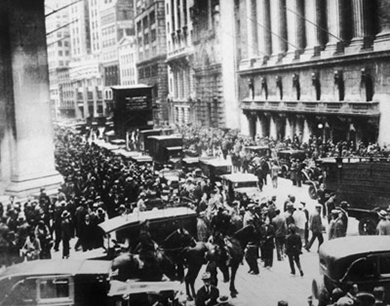| << Chapter < Page | Chapter >> Page > |
On Black Tuesday , October 29, stock holders traded over sixteen million shares and lost over $14 billion in wealth in a single day. To put this in context, a trading day of three million shares was considered a busy day on the stock market. People unloaded their stock as quickly as they could, never minding the loss. Banks, facing debt and seeking to protect their own assets, demanded payment for the loans they had provided to individual investors. Those individuals who could not afford to pay found their stocks sold immediately and their life savings wiped out in minutes, yet their debt to the bank still remained ( [link] ).

The financial outcome of the crash was devastating. Between September 1 and November 30, 1929, the stock market lost over one-half its value, dropping from $64 billion to approximately $30 billion. Any effort to stem the tide was, as one historian noted, tantamount to bailing Niagara Falls with a bucket. The crash affected many more than the relatively few Americans who invested in the stock market. While only 10 percent of households had investments, over 90 percent of all banks had invested in the stock market. Many banks failed due to their dwindling cash reserves. This was in part due to the Federal Reserve lowering the limits of cash reserves that banks were traditionally required to hold in their vaults, as well as the fact that many banks invested in the stock market themselves. Eventually, thousands of banks closed their doors after losing all of their assets, leaving their customers penniless. While a few savvy investors got out at the right time and eventually made fortunes buying up discarded stock, those success stories were rare. Housewives who speculated with grocery money, bookkeepers who embezzled company funds hoping to strike it rich and pay the funds back before getting caught, and bankers who used customer deposits to follow speculative trends all lost. While the stock market crash was the trigger, the lack of appropriate economic and banking safeguards, along with a public psyche that pursued wealth and prosperity at all costs, allowed this event to spiral downward into a depression.
The National Humanities Center has brought together a selection of newspaper commentary from the 1920s, from before the crash to its aftermath. Read through to see what journalists and financial analysts thought of the situation at the time.
The crash of 1929 did not occur in a vacuum, nor did it cause the Great Depression. Rather, it was a tipping point where the underlying weaknesses in the economy, specifically in the nation’s banking system, came to the fore. It also represented both the end of an era characterized by blind faith in American exceptionalism and the beginning of one in which citizens began increasingly to question some long-held American values. A number of factors played a role in bringing the stock market to this point and contributed to the downward trend in the market, which continued well into the 1930s. In addition to the Federal Reserve’s questionable policies and misguided banking practices, three primary reasons for the collapse of the stock market were international economic woes, poor income distribution, and the psychology of public confidence.

Notification Switch
Would you like to follow the 'U.s. history' conversation and receive update notifications?